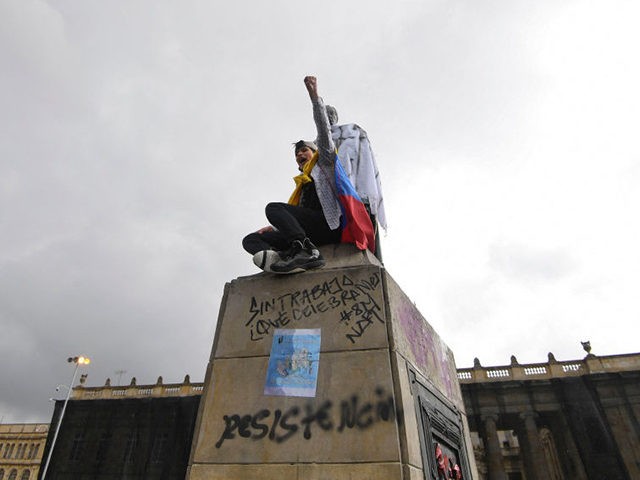The Ministries of Health and Culture of Colombia have documented dozens of violent attacks on health workers and cultural sites, particularly statues, this week, calling into question claims that nationwide leftist riots are an organic civilian uprising against police brutality.
Protests erupted against the government of President Iván Duque last week after he announced a proposed overhaul to the tax system to help fund the federal government after a year of economic devastation due to the Chinese coronavirus pandemic. Duque’s reforms, which would have substantially raised taxes on most Colombians, received immediate and furious bipartisan condemnation, prompting Duque to announce he would no longer pursue the proposal on Sunday.
The end of the tax hike controversy did not prevent syndicalist leftist groups from organizing a “national strike” in any event, following leftist violence on International Workers’ Day that appeared to have little to do with the nation’s rejection of Duque’s proposed progressive tax. The “national strike” has unleashed dramatic scenes of violence on the country, particularly targeting police stations. At least five major cities have seen violent leftist rioters firebomb police stations and attempt to burn officers alive.
The organizers of the “national strike,” who have carefully avoided a high profile, have not stated any particular goal of their efforts or made specific demands that Duque would be able to satisfy to end the violence. The nation’s attorney general said in a public statement on video this week that Bogotá believes that individuals tied to terrorist groups like the Revolutionary Armed Forces of Colombia (FARC) have taken a prominent role in violence against civilians in the “strike.”
On Friday, citing federal officials, the Argentine news portal Infobae noted a significant increase in attacks on health workers in the past week throughout Colombia, a particularly alarming development given the ongoing coronavirus pandemic.
According to the Health Ministry, its medical mission documented 126 attacks against its workers in the past week and 66.6 percent of all attacks against health workers in 2021 have occurred during the “national strike,” which began last week. Of the recent 126 attacks, 64 were classified as personal assaults and threats against health workers and 62 as attacks on ambulances and ambulance workers/patients.
The government documented these targeted attacks as separate from attempts to blockade roads to prevent the transport of critical medical supplies like oxygen. A core feature of the “national strike” is the use of human shields and material roadblocks to prevent free travel nationwide, pressuring the government to cede to the mob’s nebulous demands.
The youngest known victim of these attacks is a premature infant. Rioters attacked an ambulance in the Cundinamarca department, or regional division, on Tuesday, first blockading the road in which it was traveling and then stoning it. A woman inside the ambulance had entered premature labor and, due to the attack, could not reach a hospital or any medical facility. The attempts to save her child in the ambulance, amidst the mob, failed.
Colombia’s Ministry of Culture, which maintains and catalogues the nation’s historical sites, revealed on Thursday that it, too, had suffered a surge in attacks on monuments and other locations under its purview during the “national strike.” According to Infobae, the ministry identified attacks on “cultural infrastructure” in ten of the nation’s 32 departments, its regional division (a 33rd, the federal district of Bogotá, is not considered a “department”).
“We have reports of affected areas in Antioquia, Bogotá, Caldas, Cauca, Cesar, Huila, Nariño, Risaralda, Santander y Valle del Cauca,” Culture Minister Felipe Buitrago told reporters on Thursday. “Culture is one of the most fundamental aspects of freedom of expression and these acts of violence are an attempt against this fundamental right.”
The minister detailed attacks on at least five statues – including one of revered South American political figure Simón Bolívar – and attacks on theaters, musical sites, public libraries, and other pieces of public art. One of the most dramatic attacks on cultural sites occurred on Thursday: the destruction of a statue of Gonzalo Jiménez de Quesada, the founder of Bogotá, in the capital city by a group of self-described Misak indigenous people. The statue was a gift from the government of Spain to celebrate the 430th anniversary of the founding of the city.
An unidentified leader of the group justified the action by declaring Jiménez Quesada a “genocider and inciter of the massacre of indigenous people in the country.” The toppling reportedly occurred in the pre-dawn hours of Friday, but indigenous groups continued to celebrate it throughout Friday by surrounding the toppled statue and playing traditional drums and flutes around it.
Colombia’s Public Defense office has documented 26 deaths tied to the week-long riots, 145 disappearances, and hundreds of injuries, according to Colombia’s RCN News. Of the 26, 11 have been ruled homicides and will be prosecuted.
Attacks continued nationwide on Thursday night, particularly targeting police stations. Throughout the past week, most attacks against police have been attempts to destroy police emergency response stations, known in Colombia by their Spanish-language initials “CAI.” On Thursday night, police denounced a new tactic: throwing acid at police officers in an attempt to disfigure them.
The attacks follow a particularly harrowing ordeal at the La Aurora CAI in Bogotá prior to the acid attacks in which leftists attempted to burn it down by throwing Molotov cocktails at it, according to eyewitnesses. Police officers inside the station at the time of the attack told media outlets that the goal of the attack was, in part, to burn as many officers alive as possible. At least one, now identified as 28-year-old Freddy Perdomo, suffered significant burns on his face and body. Another officer, Katherine Mahecha, said she managed to escape the flames but found herself immediately surrounded by attackers, who pelted her with rocks until she fell, then attempted to kick her to death.

COMMENTS
Please let us know if you're having issues with commenting.